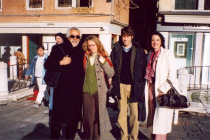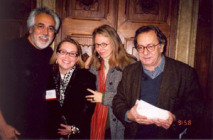Biennale 2005:
Download PDF
My aim is to advance the legitimacy of contemporary Native American arts by broadening its international exposure. I have pursued this goal for the past decade with the Indigenous Arts Action Alliance (IA3), a non-profit organization that sponsored Native arts at the Venice Biennale exhibits in 1999, 2001 and 2003. The NMAI was a contributor to the 2003 project. My role in the 2005 NMAI Biennale exhibit was as a consultant. The dilemma of contemporary Native American arts scholarship is twofold. Primarily it is a crisis of legitimacy; both self-legitimacy and recognition by others. Just as the field of Native arts is poised to come of age, the lure of the postmodern, with its celebration of hybridity, continues to diminish the credibility of distinct identity alignments in the arts.
This exile might have been feasibly overcome had not a second major variable been at play - the lack of an internal logic; a framework of significant parameters to guide the uninitiated into an appreciation of Native art forms as intellectual and social capital. These two deficits - lack of legitimacy and lack of a vocabulary - result in an invisibility of gigantic proportions. The search for recognition has everything to do with codification, the ordering of critical internal logics and social paradigms.
The IA3 cooperative advocated an indigenous knowledge systems approach to curation. Hierarchical relationships were eschewed and non-linear, consensus-driven curatorial practices sought. As with the postmodern turn, the timing of this Native-inspired approach was disastrous. Today, new power-sharing, constituent-driven exhibition practices are being advanced just as Native arts have a real and demonstratable need for authoritative positioning. I believe that in counter-logic to our earlier collaborative curatorial efforts, now is a time for decisive, persuasive curatorial mandates. A review the past three decades of group Indian art shows demonstrates the insufficiency of the collaborative logic.
Indigeneity in the arts is brought about primarily by its pedagogy - the processual aspect of making art marks the work as uniquely Native. In ordinary Western constructs, it is the object that drives the curatorial and interpretative work of the arts. Object-driven efforts necessitate an aesthetic language that signifies form, not intent. While Native artists speak of intent, Native art consumers speak of content - the direct signifier rather than the deeper meta-narrative of indigenous philosophy. Although Native artists may decry their misreading, rarely is a positive narrative attempted. There appears to be an active rejection of codification in favor of what might be perceived as an ego-centric model. This “we just are” self-legitimacy, actively repels the scholarly agendas of articulating higher-order paradigms. Yet, the arrival of contemporary native arts in a public sphere demands this ordering and authority.
Phil Deloria suggests that Indian performers of the early part of the twentieth century successfully navigated their public careers by connecting Indian sounds with Indian images, such as the stereotypical Indian princess image. While this “Indianness” brought Native actors in front of “favorably disposed audiences” it also simultaneously constricted their possibilities for effecting change. This re-appropriation of stereotypical imagery for self-gain is an established social change practice that has been mobilized with mixed success in other venues (I’m thinking here of the headbands worn at Alcatraz Island). My recommendation is aligned with the reappropriation strategy, but is not as restrictive. I suggest that the attachment of an artistic language to the visual manifestations we are witnessing in the development of the field may productively forward the legitimization and inclusion efforts of Native arts proponents.
By suggesting the establishment of an artistic language, I am not advocating for a return to such identifiers as IAIA’s “Indian art through Indian eyes” or even the Heard Museum’s “Native American Fine Art Movement.” Although these types of signage have been effective elsewhere (Thelma Golden’s “post-black” exhibit for example), the placard approach in Native arts has largely been unsuccessful. I am suggesting a deliberate, long term, slow-moving advance that strategically builds from one distinct locale to another. Again, in counter-logic fashion, this strategy calls for starting big and progressively working smaller. This is the justification for starting with the Biennale and the attention of an international audience and working back to regional and local spheres. This “jazz music in Paris, Jimi Hendrix in London” approach is by no means novel, but the timing could be right, given the already substantial presence of Native arts in Italy (Canadian pavilion 1995, Australian pavilion 1997, IA3 1999, 2001, 2003, and NMAI 2005). Pellerossa(s) in Italy are an established feature of the Biennale, justifying a continued presence in 2007. The official recognition of Native arts by the Biennale for a solid decade is a real advantage that should not be dismissed lightly. In fact, this is the most valuable asset that Native arts proponents now possess.
The difficult job of articulating a Harlem Renaissance style movement lies ahead. I am confident that given the genius of Native intellectuals and the creativity of our artists, a framework for building a comprehensible, dignified strategy of action is available to us.

